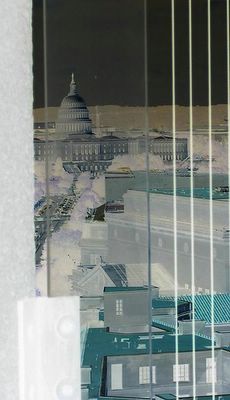GEORGETOWN: Send Me to Saint E's

(Editor's Note: With the current public hearings surrounding the future of the Whitehurst Freeway, I decided to do some architectural and planning analysis of the highway's proposed removal. I might be totally wrong in my approach, but it's good to throw the ideas out there.)
CALLING THE WHITEHURST beautiful could get you committed to a hospital’s psychiatric ward. So please, find me a straight jacket for I am going to declare just that. As the District continues to hope that its plans to rid itself of the elevated structure that hovers above Georgetown’s waterfront will move forward, I am going to defend the scorned structure. In that concrete and steel viaduct, I see an ugly duckling.
My argument for keeping the Whitehurst does not hinge on traffic concerns that everyone immediately jumps to. Nor is it only dependent on those few days in the winter when falling snow magically interacts with the glowing streetlights and the shadows created by the freeway’s steel beams and old brick warehouses that line Water Street.
My concern about tearing down the Whitehurst is more symbolic.
DEMOLITION IS FAR TOO EASY of an option. In a city that is usually far too concerned about its facades than its substance, I’m not all that surprised about the reactions from those who want the structure gone.
"It's an ugly structure, which I don't like," D.C. Council member Jack Evans, D-Ward 2, was quoted this spring by The Associated Press.
In cities across the country, elevated freeways like the Whitehurst have been targeted for demolition, especially along waterfronts in need of revitalization. City officials like Evans and others late to public space reclamation game envision a version of San Francisco’s wide bayside Embarcadero or a grand Parisian-style boulevard. But the Whitehurst’s right-of-way is far too narrow to recreate such a beautiful public asset. And there are no visionary Georges-Eugène Haussmanns nor a McMillan Commission calling for anything grander than just the idea of reclaiming the waterfront just for the sake of reclaiming the waterfront (or for condo interests at the Flour Mill or Ritz-Carlton).
Simply removing the Whitehurst is far too easy of an option. And it is aesthetically risky.
Subtracting the Whitehurst from Georgetown’s waterfront, you remove the one thing that’s protecting its façade from itself. Like a bad puss-filled abscess, picking away the freeway would unmask Georgetown’s ugly hodgepodge of old brick warehouses, more modern-yet-underwhelming office and residential buildings and the Georgetown Harbour complex, which is the dominant anchor on the water. It would take more than a generation of natural free market development to totally reshape Georgetown's waterfront into something that has clear definition, something that is more appropriate for Washington.
 IF YOU STAND on the Key Bridge looking toward Georgetown and the Kennedy Center, you can follow a clear, long horizontal line along the Whitehurst, a theme that’s repeated in the Watergate and Kennedy Center and one that will be reflected in the cutting-edge design of the House of Sweden, which is currently under construction next to the Georgetown Harbour complex.
IF YOU STAND on the Key Bridge looking toward Georgetown and the Kennedy Center, you can follow a clear, long horizontal line along the Whitehurst, a theme that’s repeated in the Watergate and Kennedy Center and one that will be reflected in the cutting-edge design of the House of Sweden, which is currently under construction next to the Georgetown Harbour complex.Remove the Whitehurst, and you might as well move the House of Sweden out to a suburban office park. It will sit naked, unprotected and exposed.
My fears with a potential Whitehurst removal will be the possibility of the Georgetown waterfront turning into New York City’s West Side Highway, Route 9A. The old elevated highway began to collapse in 1973 and was eventually replaced with a boulevard that was supposed to create a more eye-pleasing visual connection between the Hudson River and the city. Instead, the busy six-lane divided highway — lined with an ugly mix of buildings much like Georgetown — it is a speed demons’ paradise. And despite numerous improvements to encourage pedestrian activity, a vibrant public waterfront that was envisioned has not yet materialized. There are too many cars speeding down the at-grade highway. Remember, the Whitehurst is part of the U.S. Highway network, signed as Route 29. Though the District may have plans to reroute traffic or accommodate it, cars could in the end ruin the idealized Parisian boulevard on the Potomac.
There are ways to improve the Whitehurst Freeway as it stands today. Just look at some of the proposals to recapture the lost space beneath New York’s elevated FDR Drive while keeping the highway. (Some of the ideas are silly, but nonetheless, improving an elevated highway doesn't mean that it must be removed.) Such viaducts don’t have to be ugly. We just choose to make them so because it is far easier to do.
>> "More stuff about buildings and food" [mattwdc]
>> "Whitehurst Freeway Deconstruction Feasibility Study" [DDOT]
- Top photo from Drew McDermott's archives [DrewMcDermott.com]
- Second photo from Rob Goodspeed [Flickr]



0 Comments:
Post a Comment
<< Home